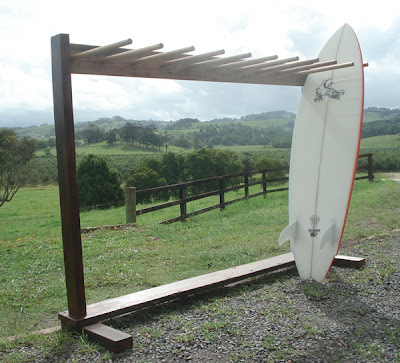
I've written about surfboard storage before, but I’ve never seen anything as eye-catching as the surf shelves from Kauai Swan. This one is the Sentinel, which comes in sizes for two, three, four or five boards.

And this design is called the Cygnet; it was designed specifically for corner space storage.
Both designs are made from “the finest quality Wisa marine grade laminated wood, harvested from environmentally sustainable birch plantations in Finland. Timber struts on the Sentinel models are of Australian hardwood.”
The products are shipped in a flat-pack; they are assembled with just a Phillips screwdriver. You can contact Kauai Swan about delivery outside the Sydney area, including overseas delivery.

If you'd prefer to keep the racks stored horizontally, take a look at Byron Bay Board Racks, such as this wedge rack for seven boards. All of these racks are made from “recycled Australian hardwoods, including iron bark, yellow box, Australian cedar and red gum to name just a few.” The wood comes from old houses, barns, decks, fences, etc.

The company also has a vertical rack, available in various sizes. You can get a protective floor mat to go with this rack, made from recycled tires.
The Byron Bay racks are shipped fully assembled. The company does not ship outside of Australia.


